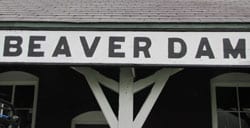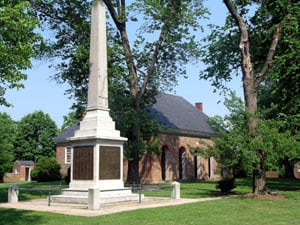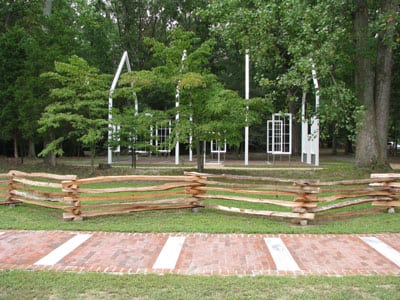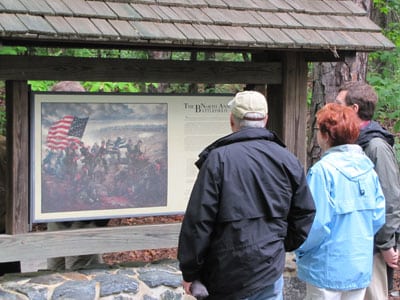Just a few miles north of Richmond lies Hanover County, a special place steeped in a long and colorful history. Throughout the county, dozens of state historic markers and numerous historic sites have been preserved to tell the stories of the earliest Native American habitants, the rich colonial history, the struggle for religious freedom and the fight for independence from the British crown. Three National Park sites and two county parks commemorate battles of the Civil War. Hanover has something for everyone, from the casual visitor to the avid American history buff.
Download the Historic Hanover County Virginia tourism map
National Register of Historic Places – Hanover County Sites
Use the Here in Hanover, VA App for a listing of historic sites.
Historic Hanover County, Virginia

Beaverdam Depot
Situated along the Virginia Central Railroad, the Beaverdam Depot was destroyed by Union cavalry raiders early in the Civil War. It was quickly rebuilt, but was destroyed and reconstructed several more times during the war. The present structure was built in 1866. Ongoing restoration is taking place. Related links: Map, Association for the Preservation of Beaverdam Depot, Historic Marker
Church Quarter
Despite its name, Church Quarter was built in 1843 as a residence. It survives as the best-preserved antebellum log dwelling in the region. Stonewall Jackson reportedly stopped here for water during his march to join Robert E. Lee prior to the 1862 Seven Days Battles. Related links: Map, Historic Marker

Hanover County Courthouse Complex
The historic courthouse (c.1735) along with the tavern, and early 19th century jail and clerk’s office, served as the political and judicial center for the county.
Here Patrick Henry successfully argued the famous “Parson’s Cause” case against the Crown in 1763, and on the eve of the Revolution, citizens of the county assembled inside the courthouse to adopt the “Hanover Resolutions.”
Hanover Junction – Doswell
Once known as Hanover Junction, this village today is called Doswell. In this tiny hamlet the tracks of important railroads intersect: the Richmond, Fredericksburg, and Potomac and Virginia Central Railroads. During the famous Civil War campaigns of 1862-1864, Robert E. Lee’s army relied on these railroads for supplies. Just to the east was the Doswell farm where the largest horseracing track in central Virginia was located. General stores and other businesses including an antique shop known today as “Squashapenny” sprang up in this community.
Hanover Tavern
(c.1733) Home to Patrick Henry (owned by his in-laws) when he argued the Parson’s Case in 1763. The existing structure dates to 1791 with a major addition in 1823. Come discover the Tavern as a historic site, a restaurant and a dinner theater. Related links: Map, Website
Polegreen Church
 This site was the center of the struggle for religious and civil liberty in the middle of the 18th century in Virginia. The Hanover dissenters, under the leadership of Presbyterian Minister Samuel Davies, challenged the established Anglican Church sponsored by the Colonial government. Patrick Henry worshiped here throughout this adolescence, and years later said, “Davies taught me what an orator should be.” The church was destroyed by Confederate artillery fire in 1864 and was never rebuilt. Related links: Map, Website
This site was the center of the struggle for religious and civil liberty in the middle of the 18th century in Virginia. The Hanover dissenters, under the leadership of Presbyterian Minister Samuel Davies, challenged the established Anglican Church sponsored by the Colonial government. Patrick Henry worshiped here throughout this adolescence, and years later said, “Davies taught me what an orator should be.” The church was destroyed by Confederate artillery fire in 1864 and was never rebuilt. Related links: Map, Website
Rural Plains
Dating from about 1723, the house stayed continuously in the Shelton family for more than 275 years. Virginia patriot and politician Patrick Henry reportedly married Sarah Shelton in its parlor in 1754. 110 years later it lay in the center of the U. S. Army’s position during the Battle of Totopotomoy Creek. It survived that action, despite being riddled with Confederate artillery fire. Related links: Map, Website
Scotchtown
(c.1720) The house and 960 acres were purchased by Patrick Henry in 1771. From here he rode to St. John’s Church in Richmond where he gave his “Liberty or Death” speech. Also served as childhood home of Dolley Madison. Related links: Map, Website
Slash Church
(c.1729) Slash Church survives as the oldest and best-preserved frame church in Virginia. Originally an Episcopal Church, the Reverend Patrick Henry, uncle of the famous patriot, served as rector here from 1737 until 1777. Its congregation included Patrick Henry, Dolley Madison, and Henry Clay. Since 1842 the church has been home to the Disciples of Christ. During the Civil War, Confederate troops bivouacked in and around the church prior to the May 1862 Battle of Hanover Courthouse. Related links: Map, Website
Sycamore Tavern
(c.1732) Sycamore Tavern was the fourth stagecoach stop on the Richmond-Charlottesville Road. The tavern hosted travelers throughout the 19th century. The well preserved building houses the Page Memorial Library of History and Genealogy. Related links: Map, Website
Civil War Sites in Hanover County
 Hanover has many sites associated with the Civil War. Most of the major battlefields can be found by following two driving trails established by the Virginia Civil War Trails program: The 1862 Peninsula Campaign and Lee vs. Grant – The 1864 Campaign. Major sites along the trails include:
Hanover has many sites associated with the Civil War. Most of the major battlefields can be found by following two driving trails established by the Virginia Civil War Trails program: The 1862 Peninsula Campaign and Lee vs. Grant – The 1864 Campaign. Major sites along the trails include:
North Anna Battlefield
Between May 23 and May 26, 1864, close to 130,000 Union and Confederate soldiers occupied fortifications along the North Anna River. The heaviest fighting occurred on the first two days. On May 27, the armies left the area on their march toward Cold Harbor. Map, Website
Gaines’ Mill Battlefield
Here on June 27, 1862, the largest battle of the famous 1862 Seven Days Campaign took place. That afternoon General Robert E. Lee’s Confederate army repeatedly assaulted a smaller Union force that was stretched along a two-mile front. This second battle of the Seven Days Campaign provided General Lee his first victory as commander of the Army of Northern Virginia. The combined casualties for both armies numbered more than 15,000.
Beaverdam Creek Battlefield
On June 26, 1862, General Robert E. Lee initiated the Seven Days Campaign by crossing the Chickahominy River with a large portion of his army. That afternoon he struck the Federals who were located behind Beaver Dam Creek. Although Lee’s army suffered five times the casualties of the Union army, the Federals abandoned their position during the night and retreated eastward toward Gaines’ Mill.
Old Church
Union infantry and cavalry passed through this hamlet on their way toward Cold Harbor in 1864. At the time a few scattered buildings comprised the community including several residences and a tavern that served as headquarters for the Union cavalry corps. The tavern stands largely unchanged from its wartime appearance. The church that gave the community its name was long gone by 1861, but just to the east stands Immanuel Church, which was converted into a Union hospital during the Cold Harbor campaign.
Enon Church
On May 28, 1864, Union and Confederate forces clashed around Enon Church in one of the fiercest cavalry battles of the Civil War. The seven-hour battle, known as Haw’s Shop, erupted when horsemen from both armies collided while on reconnaissance in front of the main armies. After a brief fight on horseback, Confederate cavalry fell back west of the church and built fortifications to withstand the Union assaults. The sides battled indecisively for several hours before the arrival of General George Custer’s Union brigade turned the stalemate into victory. The fighting resulted in nearly 800 combined casualties. Currently, the church remains open with an active congregation.
Cold Harbor Battlefield
Union and Confederate forces collided at the crossroads known as Cold Harbor on May 31, 1864. Within hours thousands of troops began to converge on the area, constructing fortifications that stretched for more than seven miles. On June 3, Union forces under General Ulysses S. Grant attempted to break through the Confederate defenses in one of the most memorable frontal assaults of the war. These futile attacks produced thousands of casualties. The armies remained in position until June 12, when Grant secretly moved his men south and east toward Petersburg. Map, Website

